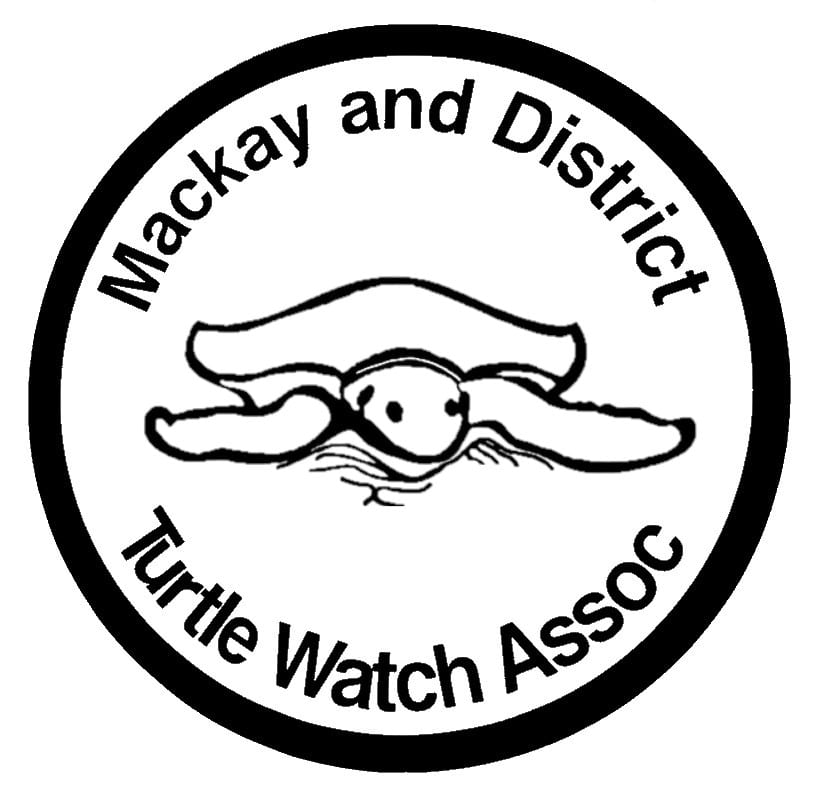Report on habitat use by flatback turtles off the Mackay coast and their migration routes – 2014-2015 nesting season
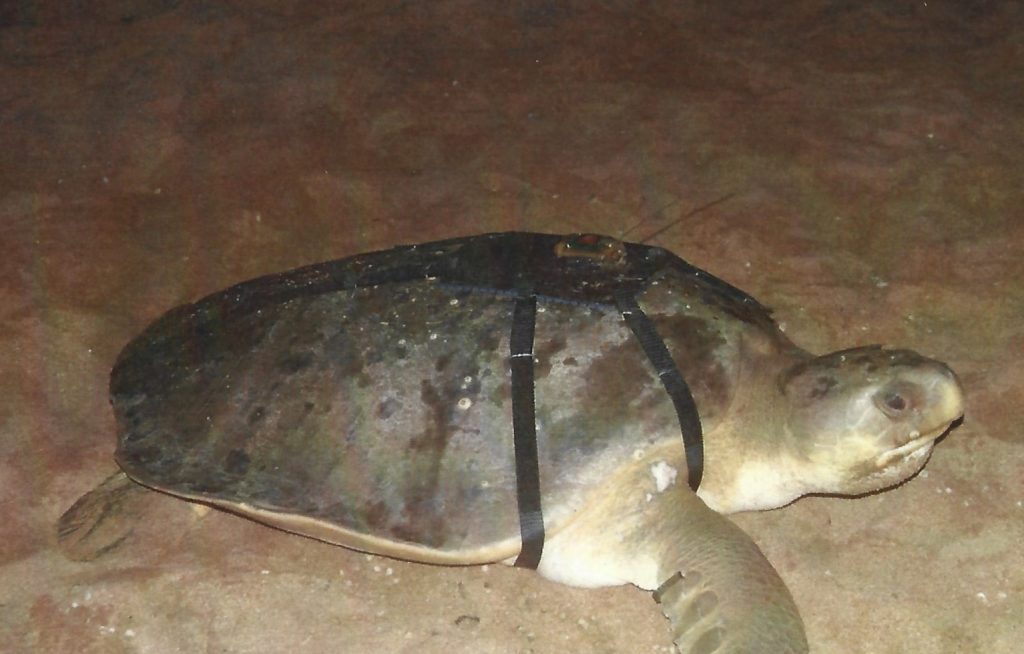
Mark Hamann, Natalie Wildermann, James Cook University
Produced as a report to the Mackay and District Turtle Watch Association Executive summary
Marine turtles lay several clutches of eggs in a breeding season at intervals of around 14 days. After laying her first clutch a female will generally remain close to the nesting beach and the period between a turtle laying one clutch and her attempt at a subsequent clutch is known as the inter-nesting period.
We used GPS satellite tags to examine the movement patterns of female turtles nesting in the Mackay region to understand the extent to which flatback turtles used the area during their inter-nesting period. This report summarises data collected from November 2014 to July 2015.
In November 2014 four flatback turtles were caught after they completed a nesting cycle. They were each fitted with a satellite tag configured to transmit GPS location and depth.
All four turtles remained within the Mackay region to lay more clutches of eggs, thus providing data on habitat use during the inter-nesting period. To look at habitat use we examined the distribution and density of GPS locations for each turtle to determine core habitat use areas.
The size of the core habitat used by the four turtles during the inter-nesting period ranged between 90-150 km2.
At the completion of the nesting season 3 of the 4 turtles migrated away from the region. One migrated to the north, one remained in Repulse Bay and the third female migrated to the southern Great Barrier Reef. All four turtles remained in the Great Barrier Reef World Heritage Area.
Introduction: The flatback turtle is a vulnerable species that breeds in the Mackay region, including Blacks Beach and Halliday Bay. Because we know little about the use of coastal habitats by flatback turtles during the nesting season we aimed to document the inter-nesting turtle behavior, map the migration routes and understand where the turtles lived outside of the nesting season.
Therefore, this study deployed GPS linked satellite tags on breeding flatback turtles and examined the data for high-resolution movement, behaviour, and habitat use in the Mackay regions. Ultimately, this work will increase the understanding of flatback turtle use of marine habitats in the central and northern Queensland region of the Great Barrier Reef Marine Park.
Methods: Field Trip
The capture of turtles and attachment of tags was conducted in partnership with Mackay and District Turtle Watch Association. One turtle was caught at Ball Bay, one at Halliday Bay and 2 at Blacks Beach. Each of them was caught after they had completed laying eggs and returning to the water. They were each fitted with Mackay Regional Council supplied Wildlife computers MK10 Splash GPS tags with depth and temperature sensors. The tags were attached with a harness (Figure 1) and in accordance with research permits.

Data analysis:
The satellite tags provide two types of location data; ARGOS PTT locations and Fast-loc GPS locations. ARGOS PTT locations are less accurate (-150 m for the best quality locations) compared to Fast-loc GPS locations (-50 m for the best quality locations) (Hazel 2009). Once the raw tracking data are downloaded from the ARGOS website we convert the raw locations to GPS data by using the Wildlife Computers software. Both ARGOS PTT and Fast-loc GPS Data were filtered in two ways. First, using the Wildlife Computers software, we omitted locations with a residual error >30 or with fewer than four satellites. Second, we used the techniques described in Shimada et al. (2012). We mapped the inter-nesting period and migration of each turtle in ArcGIS.Results
Inter-nesting information:
All of the four turtles tagged remained in the Mackay region for one inter-nesting period and thus laid at least two clutches of eggs. The four turtles used inter-nesting habitat that spanned from Blacks Beach north to the southern reaches of Repulse Bay. All inter-nesting habitat was within 25 km of the coast and none of the turtles used the waters within the Mackay Port Limits during the interesting period (Figure 2). The overall size of the core habitat used by the turtles ranged from 90-150 km2.
Migration and foraging area information:
Migration data were obtained for three of the four turtles (Figures 3 to 6, Table 1). Each of the turtles migrated between 70 and 1000 km. One migrated to the north, one remained in Repulse Bay and the third female migrated to the southern Great Barrier Reef. All four turtles remained in the Great Barrier Reef World Heritage Area.

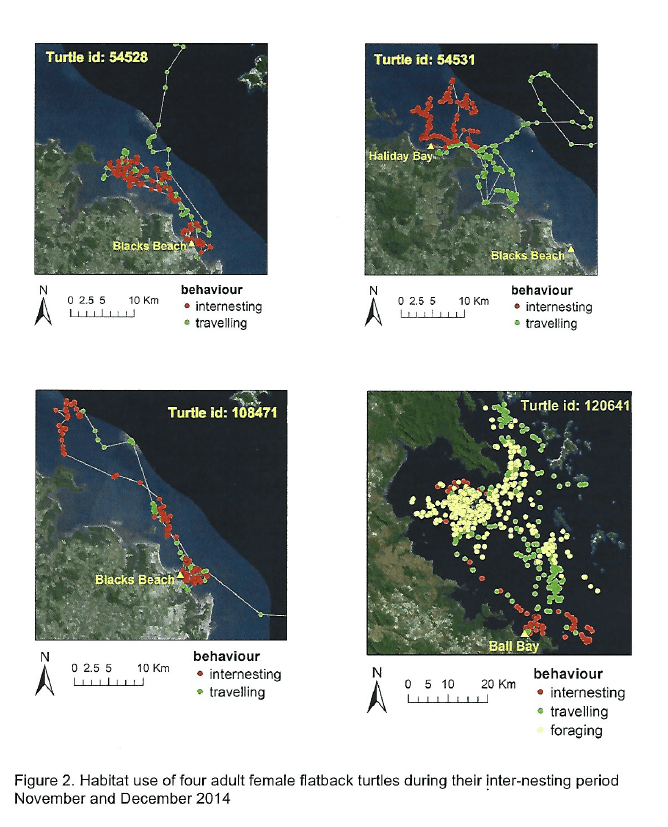
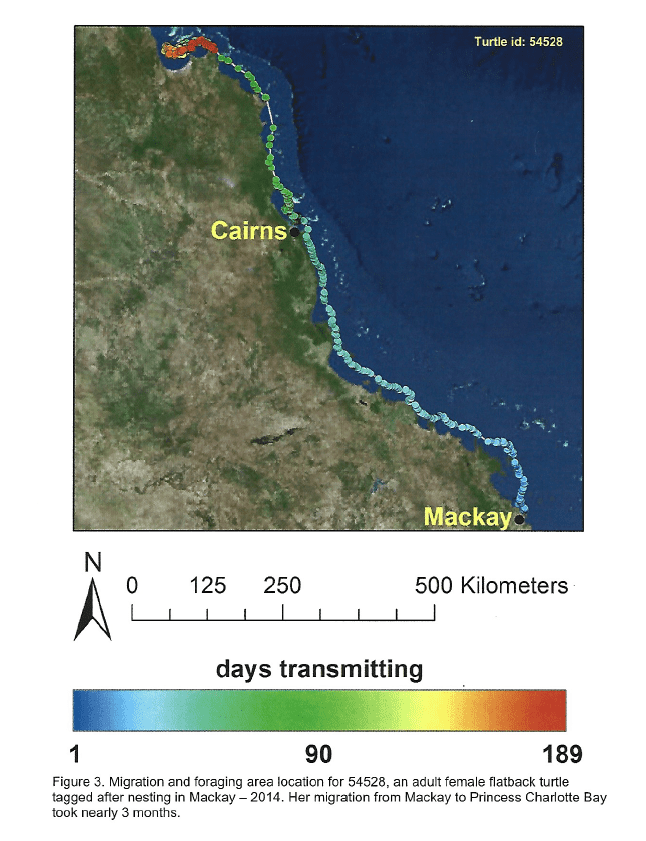

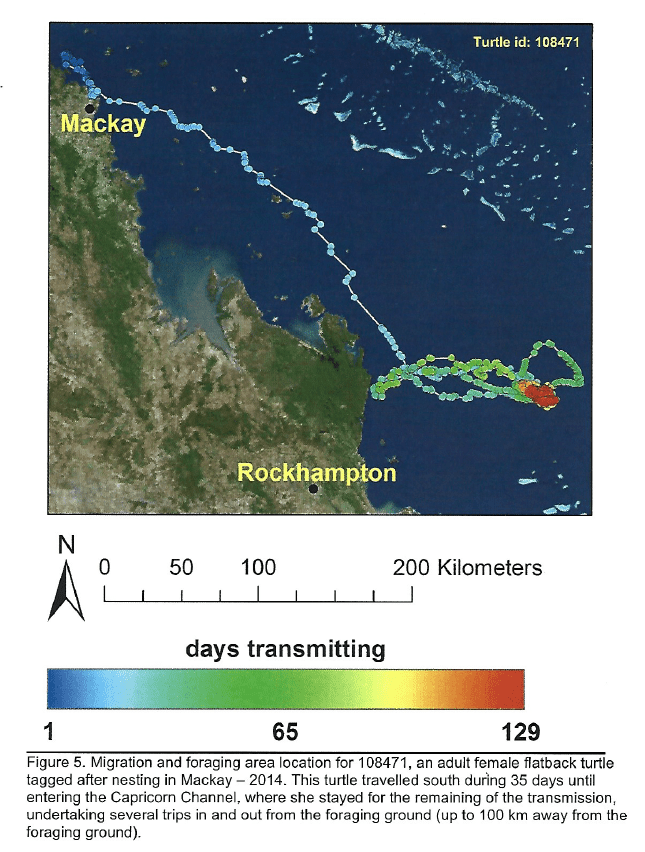
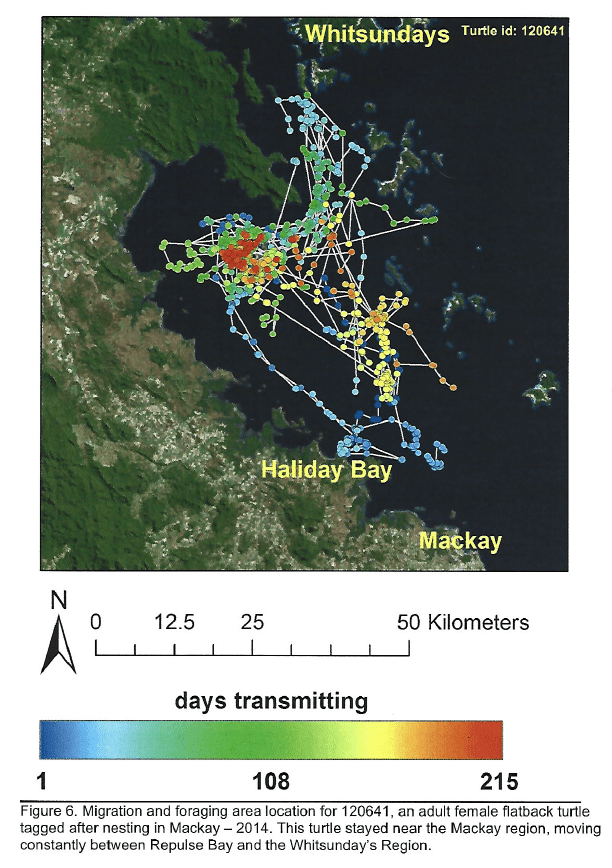
Discussion:
We tracked four turtles during their inter-nesting period and all of them spent time within the waters of the Mackay region. These areas are within the range reported by other researchers on flatback turtles (Whittock et al. 2014). We confirmed the use of Mackay waters by inter nesting flatback turtles.
Although none of the females used waters of the Mackay Port limits during their inter-nesting period, one turtle migrated through the Mackay Port’s waters and the female who migrated north swam through, or near, the Port waters of Abbott Point, Townsville and Cairns. A portion of each turtle’s migration and foraging areas was within the shipping channel of the GBR. The risk from shipping on migrating and foraging marine turtles in the GBR has not yet been investigated.
Acknowledgements:
We thank Ken and Fay Griffin, Tuka and Helen Austin and the volunteers of the Mackay and District Turtle Watch Association. Funding for the project was generously provided by Mackay Regional Council.
References:
Benhamou S (2011) Dynamic approach to space and habitat use based on biased random bridges. PLoS One 6: e14592. doi:10.1371/journal.pone.0014592
Gredzens C, Marsh H, Fuentes MMPB, Limpus CJ, Shimada T, Hamann M. (2014) Satellite Tracking of Sympatric Marine Megafauna Can Inform the Biological Basis for Species Co Management. PLoS ONE 9(6): e98944. doi:10.1371/journal.pone.0098944.
Hazel J. (2009) Evaluation of fast-acquisition GPS in stationary tests and fine-scale tracking of green turtles. Journal of Experimental Marine Biology and Ecology, 374(1): 58-68.
Shimada T, Jones RE, Limpus C, Hamann M (2012) Improving data retention and home range estimates by data-driven screening. Marine Ecology Progress Series 457:171-180.
Sperling JB (2007) The behaviour and physiology of the gravid flatback turtle (Natator depressus). MSc Thesis, The University of Queensland.
Whittock PA, Pendoley KA, Hamann M. (2014) Inter-nesting distribution of flatback turtles Natator depressus and industrial development in Western Australia. Endangered Species Research 26: 25-38.
